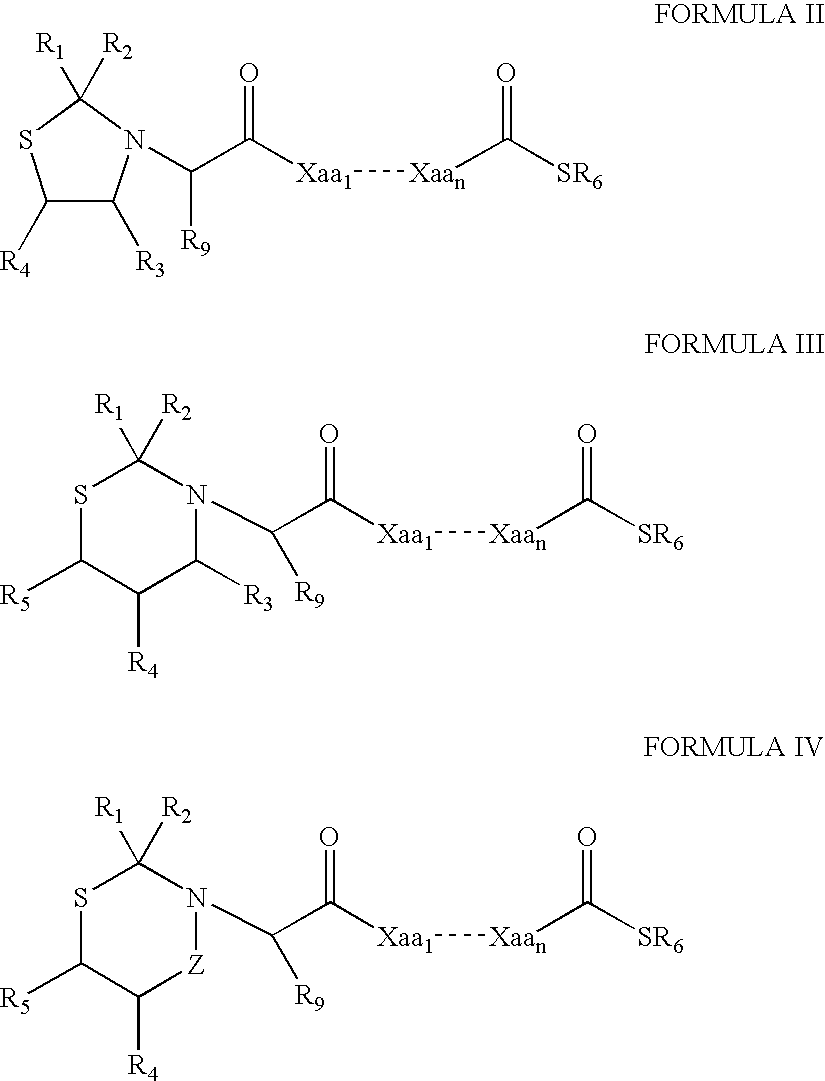Chemical peptide ligation with three or more components
- Summary
- Abstract
- Description
- Claims
- Application Information
AI Technical Summary
Benefits of technology
Problems solved by technology
Method used
Image
Examples
example 1
Synthesis of 1,3-thiazolidine-protected oligopeptide thioester
[0080] In this example, an N-terminal 4-substituted 1,3-thiazolidine-protected oligopeptide thioester having amino acid sequence GAVVFVTRKNRQVSANPEKKAVREYINSLELL (SEQ ID NO: 2) was synthesized in accordance with scheme 2 outlined above, and illustrated in FIG. 6.
[0081] Bromoacetylated oligopeptide thioester (600) was prepared as follows: AVVFVTRKNRQVSANPEKKAVREYINSLELL (SEQ ID NO: 3) was synthesized using conventional peptide chemistry as described above in a 0.1 mmole scale, after which its α-amine was deprotected by treatment with TFA followed by neutralization with 10% diisopropylethylaniine (DIEA) (Aldrich). 4 mmole BrCH2COOH (MW=133.91(555 mg)) was combined with 2 mmole diisopropylcarbodiimide (DIC) in 3 mL dimethylformamide (DMF) (6.65 M, or 310 μL) and incubated at room temperature for 15-20 minutes, after which the solution was added to the deprotected oligopeptide on the resin. The deprotected oligopeptide and ...
example 2
Synthesis of Nα-(5-methoxyphenyl-1,3-thiazolidine)-substituted glycine
[0082] In this example, heterocylic-protected glycine is synthesized by first forming an Nα-(auxiliary group)-substituted glycine, followed by deprotection and then cyclization by reaction with formalehyde. Triphenylmethyl mercaptan (Aldrich), 4 mmol, and 4′-methoxy-2-bromoacetophenone (Aldrich), 4 mmol, are dissolved in 2 mL DMF, after which 4 mmol DIEA is added. The mixture is stirred at room temperature for 1 hour, after which it is poured in diluted HCl, extracted with ethylacetate, and dried over sodium sulfate. The resulting oil is dissolved in ethylacetate and precipitated by addition of petroleum ether, which after evaporation gives a white solid, 4′-methoxy-2-(triphenylmethylthio)-acetophenone. This compound, 1.44 mmol, and aminoxyacetic acid, 4.3 mmol, are dissolved in 20 mL of trimethylorthoformate (TMOF), after which 0.047 mL of methanesulfonic acid is added as a catalyst. After incubation at room tem...
example 3
Ligation of Nα-(1-methyl-5-methoxyphenyl-1,3-thiazolidine)-Protected Oligopeptide Thioester
[0084] In this example, an Nα-(1-methyl-5-methoxyphenyl-1,3-thiazolidine)-protected oligopeptide thioester (fragment 2) was ligated in solution to oligopeptide (fragment 1) having an N-terminal cysteine. The masses of the reactants were determined by electrospray mass spectrometry (model Esquire, Brücker Bremen, Germany) to be 958 for fragment 1 and 4008 for fragment 2.
SEQFragmentID NOSequence of Oligopeptide Reactant11CYAKYAKL-COOH22thiazolidine-GAVVFVTRKNRQVSANPEKKAVREYINSLELL-thioester
[0085] Thioester formation. Fragment 2 was synthesized on a thioester generating resin. For this purpose S-acetylthioglycolic acid pentafluorophenylester was coupled to a Leu-PAM resin under conditions essentially as described by Hackeng et al (cited above). The resulting resin was used as a starting resin for peptide chain elongation on a 0.2 mmol scale after removal of the acetyl protecting group with a 3...
PUM
| Property | Measurement | Unit |
|---|---|---|
| Acidity | aaaaa | aaaaa |
| Composition | aaaaa | aaaaa |
| Efficiency | aaaaa | aaaaa |
Abstract
Description
Claims
Application Information
 Login to View More
Login to View More - R&D
- Intellectual Property
- Life Sciences
- Materials
- Tech Scout
- Unparalleled Data Quality
- Higher Quality Content
- 60% Fewer Hallucinations
Browse by: Latest US Patents, China's latest patents, Technical Efficacy Thesaurus, Application Domain, Technology Topic, Popular Technical Reports.
© 2025 PatSnap. All rights reserved.Legal|Privacy policy|Modern Slavery Act Transparency Statement|Sitemap|About US| Contact US: help@patsnap.com



